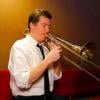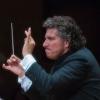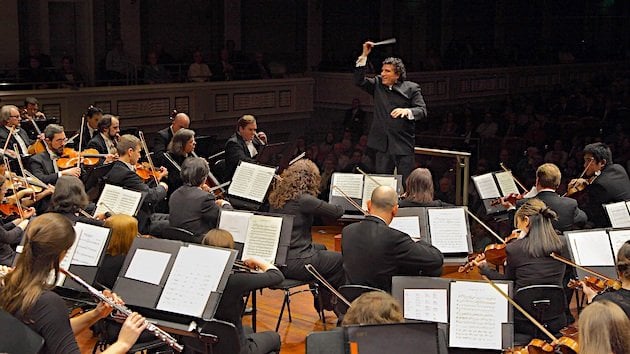
American music lost Christopher Rouse to cancer a year ago this month — and that sad news reminded us that a good deal of his music seemed to be focused upon anguish and mourning. In some ways, he was our national musical pallbearer and an often eloquent one, trying to extend the line of symphonies decades beyond the genre’s alleged expiration date somewhere in the 20th century.
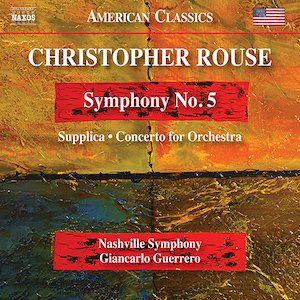 Rouse wrote six symphonies in all; the first four were recorded, and now the Symphony No. 5 has been issued on Naxos in a performance by Giancarlo Guerrero and the Nashville Symphony, an ensemble that recently was forced to cancel its entire 2020–2021 season, due to the pandemic. Guerrero also includes a shorter work, Supplica, as an intermezzo, and another major Rouse piece, the Concerto for Orchestra, rounding out the disc (heard here on a stream) quite expansively. All are relatively late works from his last 11 years, the symphony and concerto are world-premiere recordings.
Rouse wrote six symphonies in all; the first four were recorded, and now the Symphony No. 5 has been issued on Naxos in a performance by Giancarlo Guerrero and the Nashville Symphony, an ensemble that recently was forced to cancel its entire 2020–2021 season, due to the pandemic. Guerrero also includes a shorter work, Supplica, as an intermezzo, and another major Rouse piece, the Concerto for Orchestra, rounding out the disc (heard here on a stream) quite expansively. All are relatively late works from his last 11 years, the symphony and concerto are world-premiere recordings.
Rouse’s symphonies often pay tribute to, and develop upon, the ideas or moods of his symphonic influences. The Symphony No. 1 channels Shostakovich at his bleakest and most pessimistic, while the Symphony No. 2 revisits Shostakovich’s satirical side before crash landing in anguish. The brilliant, smashing Symphony No. 3 is specifically labeled “after Prokofiev” — whom indeed it evokes — and a paraphrase of Wagner’s Siegfried’s Funeral March appears when the Symphony No. 4 starts to feel down in the dumps.
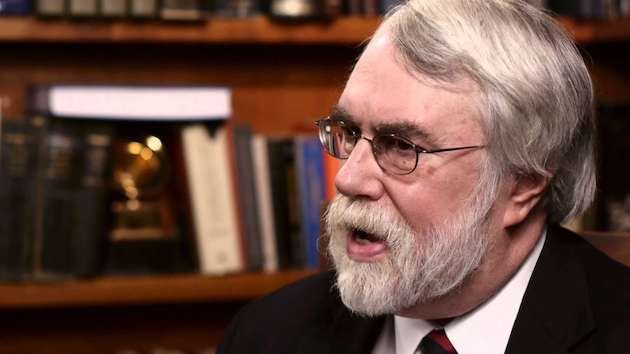
For the single-movement Symphony No. 5 — which is a bit longer than its predecessors (exactly a half-hour) and more optimistic in its outcome than all but the Third — Beethoven’s own Fifth is the launch point. Like Charles Ives before him, Rouse is fixated upon the dah-dah-dah-DAH motto, arguably the four most famous notes in classical music, quoting its rhythm in his auspiciously energetic opening and elsewhere. There is plenty of energetic contrapuntal development, plenty of attractive hustle and bustle, followed by lyrical introspection entirely free of the anguish of earlier symphonies. Ultimately everything gathers strength and comes to a convincingly triumphant, slam-bang finish, with the last big-band chord closing it out like Stravinsky’s Symphony in Three Movements.
Supplica consists of one slow movement that sings out, contemplates, and luxuriates in an American elegy manner that suggests Barber’s famous Adagio for Strings more than any European models. The Concerto for Orchestra is also in one movement, but the divisions aren’t as clearly structured as in the Symphony, vacillating back and forth between hyper workouts and slower sections whose connecting thread can be hard to follow. Nevertheless, Rouse is a master of orchestration, delighting the ear with exploitation of individual voices. And after a bass drone undergirds skyrocketing winds, a glittering finale restores the tension of the opening music and goes hammering down the stretch.
“I may sometimes take you to places where you’ll find it difficult to go,” Rouse wrote forebodingly in the album notes, “but my goal will always be at journey’s end to provide you with solace and strength.” In these works, at least, Rouse delivers solace and strength as promised. Next, what we really need is a recording of Rouse’s towering, terrifying, compassionate, no-holds-barred Requiem, which Grant Gershon hopes to record with his Los Angeles Master Chorale someday.



